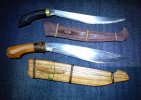Just wondering: while I do understand the need for differential tempering going from the cutting edge (belly) towards the spine, can someone enlighten me why the same process is employed along the cutting edge as well? I understand that a more malleable tip won't chip when digging etc. ...I am still not sure about having the sweet spot harder than the rest of the cutting edge that "flows" toward the handle. Can someone explain this? Other than adding to the "springiness" of the blade, having a portion easier to sharp for non-chopping chores - feel free to correct me / add something new. I see other traditional makers having this feature, while I am not sure the "modern" ones follow the same pattern.
Also, on kukri w/o the traditional ring handle...such as the M43...any tips on minimizing the chance of one parting with a few fingers? How "grippy" are the handles? Haven't handled one (yet), but thought why not ask first, while the USPS still does its thing :grumpy:.
How "grippy" are the handles? Haven't handled one (yet), but thought why not ask first, while the USPS still does its thing :grumpy:.
Also, on kukri w/o the traditional ring handle...such as the M43...any tips on minimizing the chance of one parting with a few fingers?

